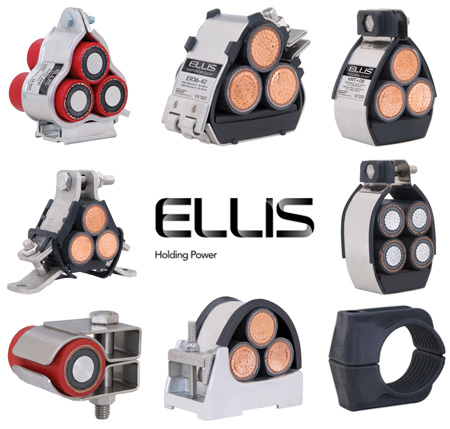
|
|
| home | contact | team t&d | group websites | markets | exports | blog |
 |
|
Vital Short Circuit Protection With Ellis Patents Cable Cleats
By Chris Dodds on 25th February, 2013

Ellis Patents Stainless Steel Cable Cleats
Ellis Patents are a leading voice in the campaign to have cable cleats reclassified as short-circuit protection devices. A move that would mean cable cleats would be placed on a parallel with fuses and circuit breakers. Conducting a short-circuit test is the only reliable way of proving that a cable cleat is capable of withstanding a specific set of fault conditions.

"This reclassification makes absolute sense. In the event of a cable fault, the forces between cables reach their peak in the first quarter cycle, which is the point that cable cleats earn their crust. In contrast, circuit breakers typically interrupt the fault after 3 or even 5 cycles by which time, if the cable cleats are underspecified, the cables will no longer be secure, but will be putting vital electrical installations and lives at unnecessary risk," says Paul Nolan UK Sales Manager, EP.
A cable cleat is a device designed to provide securing of cables when installed at intervals along the length of the cables. Ellis Patents cleats are IEC 61914 cable cleats for electrical installations and all Ellis stainless steel cable cleats are produced from 316L austenitic stainless steel.
- Further Reading
Invitation
Thorne & Derrick are inviting you to join LinkedIn’s fastest growing Discussion Group : Low & High Voltage Power, Cabling, Jointing, & Hazardous Area Electricals (LV-HV).
Discussion subjects include cable installations, cable jointing, electrical substation, overhead line and electrical construction at LV, 11kV, 33kV and EHV.
Network, engage and promote your profile, company or products with over 10,000 influencers.
 |
Category: Cable Cleats & Cable Ties
Sort by Category:
- #ThrowBackThursday
- 3M Scotch Tapes
- ABB Power Products
- Business
- Cable Accessories
- Cable Cleats & Cable Ties
- Cable Containment LV HV
- Cable Crimping & Cutting Tools
- Cable Jointer Training Courses
- Cable Jointing - PhotoBlog
- Cable Labelling & Marking
- Cable Laying & Cable Pulling
- Cable Transits & Duct Sealing
- Company Updates
- Earthing & Lightning Protection
- Electrical Equipment HV
- Electrical Equipment LV
- Electrical Safety & Arc Flash
- Exports
- Flexible Conduit Cable Management
- Hazardous Area Electricals & Lighting
- HV Cable Jointing & Terminating
- LV Cable Jointing & Terminating
- Nexans Euromold Cable Accessories
- Plugs & Sockets
- Power Distribution & Feeder Pillars
- Prysmian FP Cables
- PV Solar Farms
- Rail
- T&D History Blog
- Terms & Conditions of Sale & Purchase
Tweets by @ThorneanDerrick






























